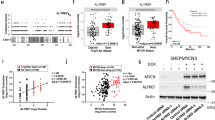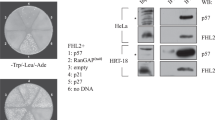Abstract
Ebp1, an ErbB3 receptor-binding protein, inhibits cell proliferation and acts as a putative tumor suppressor. Ebp1 translocates into the nucleus and functions as a transcription co-repressor for E2F-1. Here, we show that Ebp1 p42 isoform can be sumoylated on both K93 and K298 residues, which mediate its nuclear translocation and are required for its anti-proliferative activity. We find that translocation in liposarcoma (TLS)/FUS, an RNA-binding nuclear protein that is involved in pre-mRNA processing and nucleocytoplasmic shuttling, has Sumo1 E3 ligase activity for Ebp1 p42. Ebp1 directly binds TLS/FUS, which is regulated by genotoxic stress-triggered phosphorylation on Ebp1. Ebp1 sumoylation facilitates its nucleolar distribution and protein stability. Overexpression of TLS enhances Ebp1 sumoylation, whereas depletion of TLS abolishes Ebp1 sumoylation. Moreover, unsumoylated Ebp1 mutants fail to suppress E2F-1-regulated transcription, resulting in loss of its anti-proliferation activity. Hence, TLS-mediated sumoylation is required for Ebp1 transcriptional repressive activity.
This is a preview of subscription content, access via your institution
Access options
Subscribe to this journal
Receive 50 print issues and online access
$259.00 per year
only $5.18 per issue
Buy this article
- Purchase on Springer Link
- Instant access to full article PDF
Prices may be subject to local taxes which are calculated during checkout






Similar content being viewed by others
References
Ahn JY, Liu X, Liu Z, Pereira L, Cheng D, Peng J et al. (2006). Nuclear Akt associates with PKC-phosphorylated Ebp1, preventing DNA fragmentation by inhibition of caspase-activated DNase. EMBO J 25: 2083–2095.
Aman P, Panagopoulos I, Lassen C, Fioretos T, Mencinger M, Toresson H et al. (1996). Expression patterns of the human sarcoma-associated genes FUS and EWS and the genomic structure of FUS. Genomics 37: 1–8.
Andersen JS, Lam YW, Leung AK, Ong SE, Lyon CE, Lamond AI et al. (2005). Nucleolar proteome dynamics. Nature 433: 77–83.
Bae SH, Jeong JW, Park JA, Kim SH, Bae MK, Choi SJ et al. (2004). Sumoylation increases HIF-1alpha stability and its transcriptional activity. Biochem Biophys Res Commun 324: 394–400.
Bossis G, Malnou CE, Farras R, Andermarcher E, Hipskind R, Rodriguez M et al. (2005). Down-regulation of c-Fos/c-Jun AP-1 dimer activity by sumoylation. Mol Cell Biol 25: 6964–6979.
Crozat A, Aman P, Mandahl N, Ron D . (1993). Fusion of CHOP to a novel RNA-binding protein in human myxoid liposarcoma. Nature 363: 640–644.
Falini B, Nicoletti I, Bolli N, Martelli MP, Liso A, Gorello P et al. (2007). Translocations and mutations involving the nucleophosmin (NPM1) gene in lymphomas and leukemias. Haematologica 92: 519–532.
Gill G . (2005). Something about SUMO inhibits transcription. Curr Opin Genet Dev 15: 536–541.
Grisendi S, Bernardi R, Rossi M, Cheng K, Khandker L, Manova K et al. (2005). Role of nucleophosmin in embryonic development and tumorigenesis. Nature 437: 147–153.
Hay RT . (2001). Protein modification by SUMO. Trends Biochem Sci 26: 332–333.
Hicks GG, Singh N, Nashabi A, Mai S, Bozek G, Klewes L et al. (2000). Fus deficiency in mice results in defective B-lymphocyte development and activation, high levels of chromosomal instability and perinatal death. Nat Genet 24: 175–179.
Hochstrasser M . (2001). SP-RING for SUMO: new functions bloom for a ubiquitin-like protein. Cell 107: 5–8.
Huen MS, Chen J . (2008). The DNA damage response pathways: at the crossroad of protein modifications. Cell Res 18: 8–16.
Inoue Y, Kitagawa M, Taya Y . (2007). Phosphorylation of pRB at Ser612 by Chk1/2 leads to a complex between pRB and E2F-1 after DNA damage. EMBO J 26: 2083–2093.
Jackson PK . (2001). A new RING for SUMO: wrestling transcriptional responses into nuclear bodies with PIAS family E3 SUMO ligases. Genes Dev 15: 3053–3058.
Kuroda M, Ishida T, Takanashi M, Satoh M, Machinami R, Watanabe T . (1997). Oncogenic transformation and inhibition of adipocytic conversion of preadipocytes by TLS/FUS-CHOP type II chimeric protein. Am J Pathol 151: 735–744.
Kuroda M, Sok J, Webb L, Baechtold H, Urano F, Yin Y et al. (2000). Male sterility and enhanced radiation sensitivity in TLS(−/−) mice. EMBO J 19: 453–462.
Lee CD, Sun HC, Hu SM, Chiu CF, Homhuan A, Liang SM et al. (2008). An improved SUMO fusion protein system for effective production of native proteins. Protein Sci 17: 1241–1248.
Liu X, Liu Z, Jang SW, Ma Z, Shinmura K, Kang S et al. (2007). Sumoylation of nucleophosmin/B23 regulates its subcellular localization, mediating cell proliferation and survival. Proc Natl Acad Sci USA 104: 9679–9684.
Liu Z, Ahn JY, Liu X, Ye K . (2006). Ebp1 isoforms distinctively regulate cell survival and differentiation. Proc Natl Acad Sci USA 103: 10917–10922.
Meek DW . (1998). Multisite phosphorylation and the integration of stress signals at p53. Cell Signal 10: 159–166.
Morohoshi F, Ootsuka Y, Arai K, Ichikawa H, Mitani S, Munakata N et al. (1998). Genomic structure of the human RBP56/hTAFII68 and FUS/TLS genes. Gene 221: 191–198.
Muller S, Hoege C, Pyrowolakis G, Jentsch S . (2001). SUMO, ubiquitin's mysterious cousin. Nat Rev Mol Cell Biol 2: 202–210.
Nakagawa K, Kawabata S, Nakashima Y, Iwanaga S, Sueishi K . (1997). Tissue distribution and subcellular localization of rabbit liver metalloendopeptidase. J Histochem Cytochem 45: 41–47.
Okada M, Jang SW, Ye K . (2007). Ebp1 association with nucleophosmin/B23 is essential for regulating cell proliferation and suppressing apoptosis. J Biol Chem 282: 36744–36754.
Panagopoulos I, Mandahl N, Mitelman F, Aman P . (1995). Two distinct FUS breakpoint clusters in myxoid liposarcoma and acute myeloid leukemia with the translocations t(12;16) and t(16;21). Oncogene 11: 1133–1137.
Perrotti D, Iervolino A, Cesi V, Cirinna M, Lombardini S, Grassilli E et al. (2000). BCR-ABL prevents c-jun-mediated and proteasome-dependent FUS (TLS) proteolysis through a protein kinase CbetaII-dependent pathway. Mol Cell Biol 20: 6159–6169.
Prasad DD, Ouchida M, Lee L, Rao VN, Reddy ES . (1994). TLS/FUS fusion domain of TLS/FUS-erg chimeric protein resulting from the t(16;21) chromosomal translocation in human myeloid leukemia functions as a transcriptional activation domain. Oncogene 9: 3717–3729.
Rabbitts TH, Forster A, Larson R, Nathan P . (1993). Fusion of the dominant negative transcription regulator CHOP with a novel gene FUS by translocation t(12;16) in malignant liposarcoma. Nat Genet 4: 175–180.
Radomski N, Jost E . (1995). Molecular cloning of a murine cDNA encoding a novel protein, p38-2G4, which varies with the cell cycle. Exp Cell Res 220: 434–445.
Rodriguez MS, Dargemont C, Hay RT . (2001). SUMO-1 conjugation in vivo requires both a consensus modification motif and nuclear targeting. J Biol Chem 276: 12654–12659.
Ron D . (1997). TLS-CHOP and the role of RNA-binding proteins in oncogenic transformation. Curr Top Microbiol Immunol 220: 131–142.
Sanchez-Garcia I, Rabbitts TH . (1994). Transcriptional activation by TAL1 and FUS-CHOP proteins expressed in acute malignancies as a result of chromosomal abnormalities. Proc Natl Acad Sci USA 91: 7869–7873.
Shieh SY, Ikeda M, Taya Y, Prives C . (1997). DNA damage-induced phosphorylation of p53 alleviates inhibition by MDM2. Cell 91: 325–334.
Shimizu K, Ichikawa H, Tojo A, Kaneko Y, Maseki N, Hayashi Y et al. (1993). An ets-related gene, ERG, is rearranged in human myeloid leukemia with t(16;21) chromosomal translocation. Proc Natl Acad Sci USA 90: 10280–10284.
Squatrito M, Mancino M, Donzelli M, Areces LB, Draetta GF . (2004). EBP1 is a nucleolar growth-regulating protein that is part of pre-ribosomal ribonucleoprotein complexes. Oncogene 23: 4454–4465.
Watts FZ . (2006). Sumoylation of PCNA: wrestling with recombination at stalled replication forks. DNA Repair (Amst) 5: 399–403.
Wei F, Scholer HR, Atchison ML . (2007). Sumoylation of Oct4 enhances its stability, DNA binding, and transactivation. J Biol Chem 282: 21551–21560.
Xia X, Cheng A, Lessor T, Zhang Y, Hamburger AW . (2001). Ebp1, an ErbB-3 binding protein, interacts with Rb and affects Rb transcriptional regulation. J Cell Physiol 187: 209–217.
Yoo JY, Wang XW, Rishi AK, Lessor T, Xia XM, Gustafson TA et al. (2000). Interaction of the PA2G4 (EBP1) protein with ErbB-3 and regulation of this binding by heregulin. Br J Cancer 82: 683–690.
Yu Y, Chen W, Zhang Y, Hamburger AW, Pan H, Zhang Z . (2007). Suppression of salivary adenoid cystic carcinoma growth and metastasis by ErbB3 binding protein Ebp1 gene transfer. Int J Cancer 120: 1909–1913.
Zhang Y, Wang XW, Jelovac D, Nakanishi T, Yu MH, Akinmade D et al. (2005). The ErbB3-binding protein Ebp1 suppresses androgen receptor-mediated gene transcription and tumorigenesis of prostate cancer cells. Proc Natl Acad Sci USA 102: 9890–9895.
Zhang Y, Woodford N, Xia X, Hamburger AW . (2003). Repression of E2F1-mediated transcription by the ErbB3 binding protein Ebp1 involves histone deacetylases. Nucleic Acids Res 31: 2168–2177.
Zinszner H, Albalat R, Ron D . (1994). A novel effector domain from the RNA-binding protein TLS or EWS is required for oncogenic transformation by CHOP. Genes Dev 8: 2513–2526.
Zinszner H, Immanuel D, Yin Y, Liang FX, Ron D . (1997a). A topogenic role for the oncogenic N-terminus of TLS: nucleolar localization when transcription is inhibited. Oncogene 14: 451–461.
Zinszner H, Sok J, Immanuel D, Yin Y, Ron D . (1997b). TLS (FUS) binds RNA in vivo and engages in nucleo-cytoplasmic shuttling. J Cell Sci 110 (Part 15): 1741–1750.
Acknowledgements
This work is supported by grants from the National Institute of Health (RO1, CA127119) to K Ye. We thank Dr Yang Liu at Medical Research Service (VA Puget Sound Health Care System, Seattle, WA, USA) for TLS constructs.
Author information
Authors and Affiliations
Corresponding author
Additional information
Supplementary Information accompanies the paper on the Oncogene website (http://www.nature.com/onc)
Rights and permissions
About this article
Cite this article
Oh, SM., Liu, Z., Okada, M. et al. Ebp1 sumoylation, regulated by TLS/FUS E3 ligase, is required for its anti-proliferative activity. Oncogene 29, 1017–1030 (2010). https://doi.org/10.1038/onc.2009.411
Received:
Revised:
Accepted:
Published:
Issue Date:
DOI: https://doi.org/10.1038/onc.2009.411
Keywords
This article is cited by
-
A SUMO4 initiator codon variant in amyotrophic lateral sclerosis reduces SUMO4 expression and alters stress granule dynamics
Journal of Neurology (2022)
-
SUMOylation Regulates TDP-43 Splicing Activity and Nucleocytoplasmic Distribution
Molecular Neurobiology (2021)
-
The roles of multifunctional protein ErbB3 binding protein 1 (EBP1) isoforms from development to disease
Experimental & Molecular Medicine (2020)
-
A role for SUMOylation in the Formation and Cellular Localization of TDP-43 Aggregates in Amyotrophic Lateral Sclerosis
Molecular Neurobiology (2020)
-
The impact of proteostasis dysfunction secondary to environmental and genetic causes on neurodegenerative diseases progression and potential therapeutic intervention
Environmental Science and Pollution Research (2020)



